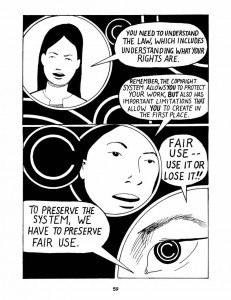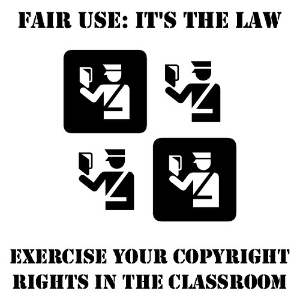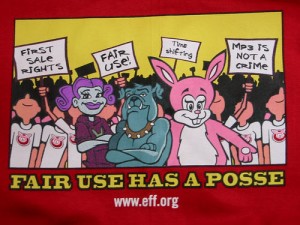I attended last week’s hearing in the 2d Circuit. Below, I post my detailed notes (taken long-hand!) from the oral argument itself. See this separate post for my thoughts about the hearing.
* Authors Guild
* Google
* Authors Guild response
Notes about the argument
Panel: Cabranes (telepresence), Parker, Leval
Attorneys: Smith arguing for Authors Guild [AG]; Waxman arguing for Google [G]
* LEVAL — There’s nothing else on the calendar, so we can go 30 minutes on each side.
AUTHORS GUILD
AG – The District Court erred in finding fair use. I readily acknowledge HathiTrust can be transformative although we preserve opposition to that for other purposes — but there are multiple reasons this case is different. First & foremost, this is “quintessentially commercial” — there are “billions and billions of dollars in revenue.”
LEVAL – [interrupts] Distinction b/we noncommercial and commercial fair use but Campbell etc are all commercial, making a profit. So I would be surprised if you were going to win a case on this.
AG – This is different in kind. This is not Koons or a parody.
LEVAL – Big profits dwindle into small profits. Newspaper sales are dwindling.
AG – …
LEVAL – If what they do doesn’t cause any harm to copyright owner why does it make a difference if it’s profitable — this is a valuable research service.
AG – There are two market harms. One, sale of the original work because Google displays the text of the book. Two, loss of opportunity to be compensated for inclusion in database altogether. Going back to Texaco, Campbell. This is not parody. This is a new form of a derivative work, in a for-profit context.
Google has a Partner Program, with 2.5 million books licensed. Amazon is also doing this. Both asking permission. The record show that Amazon’s program was stunted because of Google. Microsoft was digitizing until Google Books came along and digitized without asking permission. Rule from Texaco and Campbell about whether this is the kind of use licensed — well, it is. Market exists.
LEVAL — Pretty different from Texaco. 80 scientists, photocopying, multiplying number of copies, for all purposes.
AG – Second Circuit emerging market likely to be harmed — emergence of a licensing market that Google decided for some reason not to use for 4 million books. Google would say that their use is so transformative that the market harm is irrelevant. But the test is not transformativeness, but …
LEVAL – This strikes me as not a very useful test because no matter how transformative you will always find someone willing to pay a price to avoid a hassle. There would always be someone. So this would eliminate fair use. Consider newspaper reviews in the NYT — it might be easier for them to pay a license too.
AG – The question is do we need to go to fair use. Does use go into the unlicensed fair use bin. There is a contradiction in Google’s position — they talk about great public benefit, but —
LEVAL – Do you have any cases on if someone is willing to pay?
AG – Campbell is right there. Also Texaco. In Cariou this court said the standard is traditional, reasonable, or likely to develop. Goes to practicality and likelihood that the use will be developed. We want to reward people who make these books, especially in a world in which other revenues are shrinking — If we say these poor index companies pleading poverty don’t have to pay here — why? they’ve paid 4 million times already.
LEVAL – Libraries perhaps are less sophisticated in technology to protect against hacking. Even if Google is fair use, having multiple copies out there, as in Texaco multiplied copies, or if more vulnerable, could have very detrimental effect on the market.
AG – Your Honor, thank you for raising that. Not many restrictions by Google on libraries for example with security. But Google used these copies as CURRENCY — “the quid pro quo can itself by fair use” — HathiTrust did — but that doesn’t supply an answer as to why Google can use these copies instead of its money as an inducement to the libraries.
LEVAL – I’m not following you. Use by libraries of copies for research purposes was transformative.
AG – Princeton in the 6th Circuit coursepack cases — don’t judge fair use by end user’s goal. Leaving aside that point once you have all these copies — there’s no restriction. Stanford agreement allowed them to distribute up to 10% to any one user —
[Parker is sitting forward now. Cabranes is flipping through briefs.]
LEVAL — Stanford agreement would permit any number of students to read the book at the same time.
AG — That’s my understanding. Google didn’t do anything to limit what was done with these copies.
LEVAL — is it Google’s responsibility …?
AG – If Google is justifying it on library uses then they have to assume responsibility.
PARKER – What do you mean by assume responsibility?
AG – 2.7 million books, used as currency.
PARKER – Any provisions in documents that restrict contours of the program? We know for today’s purposes what the program looks like but what’s to keep it from changing? … They could double what they provide?
AG – Not just this user but every user. Once you legislative from bench instead of Congress — lots of different …
LEVAL — You’re not suggesting someone else would be prevented …? 8 page snippets instead of 2 page snippets?
AG – It’s the principle. Everyone will try.
PARKER – You’re not practically suggesting we wait around for Congress to address this complicated issue.
AG – Far be it from me to stand up for Congress. We’re not suggesting shut it down; just establish a royalty stream. If you conclude as I would that legislative solution is more rational than fair use.
LEVAL – Anything in contours of this program to prevent digitization of a hot new Harry Potter book?
AG – Most of newer books are in Partner Program. They would probably work a deal. Most of these are in copyright but out-of-print book rights have reverted from publishers that Google can deal with, to authors.
LEVAL – So you’re telling me my concern about hot new books is not relevant?
AG – If you approve this it could be a problem.
PARKER – Remind me — provision if I’m an author and want my work excluded – what is the mechanism?
AG – I’m unclear. At a minimum there is no way to get it out of the database. An author can request to stop displaying snippets, but not out of the search engine.
LEVAL – Author exclusion doesn’t affect library copy.
AG – Library bought it and now has second copy; nothing in contract to affect. ….
The original idea of snippets was it would not affect sales. But we do not always read books in linear fashion beginning to end.
LEVAL – But recipes, dictionaries, are not included.
AG – Google makes their own judgment but others are vulnerable. In the old days someone would have to go to the library, look it up in the catalog, pull it off of the dusty shelves, be exposed to the whole text — now they go to Google Books. Don’t assume the snippets are harmless. They will diminish the use. They are a double-edged sword — a Grand Rapids librarian says they will help locate and identify a book but someone else they will meet the need. Judge Chin ignored this. There is no evidence that this helps people sell their books. No testimony presented.
LEVAL – You have consumed your half hour. Do you want time to respond?
AG – I would enjoy coming back.
CABRANES – Judge LEVAL goes for the jugular; I go for the capillaries. This is a redacted version. What is the theory of the redactions here — can you tell me without violating some principle?
AG – Protective order.
CABRANES – What’s the theory of the protective order.
AG – Not sure; it was done at trial. I will speak to trial counsel.
LEVAL – Let’s just ask counsel on both sides if they are harmed by referring to redacted material.
AG – No objection.
[Couldn’t make out if G’s attorneys said anything.]
GOOGLE
G – Three things fundamental to this case. First, the uses here quintessentially Promote the Progress of Science and the Useful Arts. Second, collaborations between Google and the libraries to enable each to make a transformative and fair use that neither could do alone. Library books, Google scanning and optical technology. Third, there is NO evidence of ANY market harm.
LEVAL – As far as I know no evidence of market harm to books — correct. But plaintiff is arguing right to index and develop that market.
G – Yes they are making that argument. It was expressly rejected in HathiTrust. Quote: “… market for licensing books for digital search could develop in future …” No evidence in this case of any such market. They cite Amazon’s 20% display, which would be substitutional, but wasn’t paid. Expert testimony is no one would pay authors for search.
LEVAL – Amicus about licensing in Europe.
G – About reproducing the entire book. Similar to proposed class action settlement. No examples anywhere of paying even one penny for indexing. See pages 1503-1505, 1478 of Joint Appendix.
PARKER – How much was spent?
G – Well over a billion … no, more than $125 million.
PARKER – Does the record reflect how Google gets its money back?
G – No. Partner search had ads, but it generated so few revenues that Google dispensed with it.
CABRANES – This is a charitable enterprise?
G – No, no.
CABRANES – This particular program is nonprofit?
G – That’s not our contention.
CABRANES – Is there any suggestion in the record of Google making money?
G – Very little in the record about Google making money.
CABRANES – Is there anything in the record for Google to make profit?
LEVAL – No ads?
G – If you go to Google Books or general Google to search for a book by Pierre Leval, you will see ads for products. If you then click-through to Google Books you will see no ads on those pages. Google makes no money from the “buy this book” links.
PARKER – What’s to prevent Google from festooning ads on this at some point in the future?
G – Google could change it in all kinds of ways but that would be a different program. Some other program would have to be calculated differently and assessed separately. Google Book Search has an incredibly transformative purpose — to enable readers to find books. If Google makes money that does not distinguish it from most other users that make fair use. If it promotes the progress, if it’s fair use, then it’s irrelevant if it’s making money. In fact you can argue that if there is no possibility of money, eyeballs, that Google would not have developed this service that revolutionized the way people find books.
PARKER – In class certification you said there should be individual analysis; here program analysis. What changed?
G – In our view the entire Books Program is fair use, but if you don’t agree with that, then you have to look at it one at a time. Other courts — HathiTrust full text search engine & provision of copies to disabled people was fair use across the board. If court found otherwise then have to distinguish between for instance the MetroNorth 2010 schedule compilation and other books.
Google contract with the libraries required uses consistent with copyright law. If they are not, then that’s another case.
LEVAL – Careful restrictions at Google to make sure there is not too much seen. Snippets, limits, etc. Safe to say to avoid copyright infringement problems. But what if copies you give back to libraries are vulnerable to infringement? Misuses or vulnerabilities to hacking?
G – Again address security with respect to HathiTrust.
LEVAL – This is different. Hacking was merely speculative in HathiTrust; plaintiffs raised the issue but didn’t provide any evidence. Here plaintiffs have shown possibilities.
G – Google’s own system their own expert said top caliber. This program has been in effect for 10 years. No hacking into HathiTrust corpus. Makes sense because if you want to hack plaintiff Jim Bouton’s book you could buy it for $1.99 on Amazon. When you buy electronic it goes over Internet with no security. Idea of hacking is completely fanciful.
LEVAL – Digital copies are sufficiently available that hacking is not a problem?
G – Latest Harry Potter example — Google doesn’t do books within 2 years of publishing.
LEVAL – Is that in the library agreements?
G – It’s our policy. Snippets is for factor 3 & 4. But the point is to let people find books. Displaying 2, 20, 30 pages doesn’t enhance that transformative case. Even if transformativeness or market factor were only relevant — … in this case focus on the record. 3 individual plaintiffs each testified — 1421, 1434, 1437-1438 — no last sales. Also testified snippet view does not substitute — 1421-1424, 1439. So literally nothing on the other side.
LEVAL – At least one of the university agreements would permit any number of students to read the book.
G – Stanford.
LEVAL – Why is that not Texaco?
G – It would be contract breach if they violated the law. The fact that it’s not a contract breach doesn’t mean it’s fair use. Ambiguous language in contract, but language still says within federal law. 11th Circuit GSU ereserves like coursepacks. That was circ not transformative — like copyshops. What we have here — let me go to copyshops — Princeton highly divided en banc 6th was skeptical about fair use. Every factor different here [runs through factors] – here Google assisting libraries to make transformative fair use in HathiTrust.
CABRANES – Concerned about something as vulgar as money. Recognizing as Leval said money may not matter. If Google invested $100 million for profit.
G – Will stipulate.
CABRANES – Are they trying to develop a shareholder derivative action?
G – Far be it from me to encourage litigation against my client.
CABRANES – Very odd to do something just to be helpful.
PARKER – Google wants to help people find books.
G – Look at the agreements with libraries. Michigan earliest agreements — a collaborative enterprise to let each party make its own transformative uses. … Your Honor went to Google’s motives. Google wants to do this to bring readers, improve Google Translate — there’s no money there either. Mr. Smith is making a point that is astonishingly absent in the trial record — no evidence in the record that copies were given to libraries to save money. The project was conceived of by both sides to make transformative uses neither could otherwise do. We ask that you affirm the district court’s opinion across the board.
CABRANES – What pages?
G – Page 594. Quotes, “Google & … mutual interest in making info to public … accordingly, non-exclusive agreement.” This would be a different case if Google paid $100 million — still a fair sue case — but it badly distorts …
LEVAL – Will you tell me what page for the 2 year restriction?
G – I will, anon.
AUTHORS GUILD
AG – This case is on summary judgment in Google’s favor, so they have the burden of proof. Page 1290 (1219?) the motivation — see Authors Guild Paul Aiken.
– W of harm to sales caused by snippets. Like saying we haven’t proved a negative. Some college student that looked up ….
LEVAL – Can a rightsholder exclude themselves from snippet view?
AG – Yes. Fiction, history, all have same features. Waxman referred to no harm. 1421, 1434, 1439. “No way of knowing” is not the same as “no harm”.
CABRANES – Page 58 you look for a broad order from us to let District Court seek remedy etc. What do you want from us?
AG – Reverse and order back to District Court. With respect to remedy the right resolution is not to shut it down but monetized, damages and ongoing royalty, licensing going forward.
CABRANES – Monetization. You’ve had extensive settlement discussions. You could do … So you will be satisfied with a sum certain that would conclusively ….
AG – Similar to YouTube case I argued last year.
CABRANES – Monetization in settlement agreement with J. Chin.
AG – Yes, there was money as part of it — $45 million if I recall correctly.
CABRANES – Question about the state of the record. Discovery is now completed?
AG – Yes. … Other liensing arrangements parallel. It’s not fair to say markets as he does but is a database licensing market.
LEVAL – You suggested earlier settlement involved different use by Google.
AG – Yes. Settlement was rejected because Google had power to keep adding without rightsholders ever being caught up.
CABRANES – What explanation for Judge Chin’s change of gears? …
AG – No speculation. Signal from this panel. He had a different view earlier.
Reality is Google makes money from search results. … They had to make sure ….
Concern about copies in libraries is a real one. 400,000 scholarly articles downloaded by an activist a few years ago. This is real.


